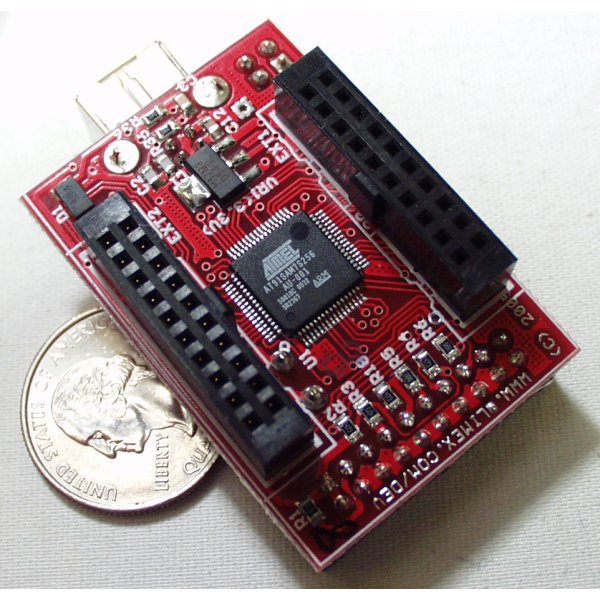Header Board Atmel SAM7-256
Replacement: None. It's time for this product to step aside and make room for more cool stuff. This page is for reference only.
Header board for the SAM7 ARM processor.
- MCU: AT91SAM7S256 16/32 bit ARM7TDMI? with 256K Bytes Program Flash, 64K Bytes RAM, USB 2.0, RTT, 10 bit ADC 384 ksps, 2x UARTs, TWI (I2C), SPI, 3x 32bit TIMERS, 4x PWM, SSC, WDT, PDC (DMA) for all peripherals, up to 60MHz operation
- Perfect solution for building custom USB peripherals
- Standard JTAG connector with ARM 2x10 pin layout for programming/debugging with ARM-JTAG
- USB connector
- RESET circuit
- RESET button
- Status LED
- TST jumper, for SAM-BA downloading
- On board voltage regulator 3.3V with up to 800mA current
- Single power supply: through USB or from extension header pin
- Power supply LED
- Power supply filtering capacitor
- 18.432 MHz crystal on socket
- Extension headers for all uC ports + RST and power supply
- PCB: FR-4, 1.5 mm (0,062"), soldermask, silkscreen component print
- Distance between the headers: 25.4 mm (1")
Software:
- 2x1.3" (50x34 mm)
Comments
Looking for answers to technical questions?
We welcome your comments and suggestions below. However, if you are looking for solutions to technical questions please see our Technical Assistance page.
Customer Reviews
No reviews yet.



You get what you pay for. A board with a SAM7-chip that is. You've got the schematic, from my experience it is all correct, what more documentation do you need?
Buyer Beware!!
The peeps @olimex are flat unresponsive. I wouldn't recommend their stuff at all. Documentation is poor at best. And yes I have sent several emails from private IP addresses to clear their SPAM filter. Ha!
Sorry for the rant but customer $ must = customer support in this industry.
All SAM7 (and almost every ARM) contain PLL's and can do extensive clock multiplying. 18.432 MHz was choosen by the designers to be able to generate proper frequency for the USB.
When will this be back in stock?
I hope to use this as a replacement for the AT91SAM7S-EK devboard from Atmel, which is $100.
The only additions I can see for my $50 are a pair of RS-232 chips and associated connectors, 4 LEDs on I/O ports, a small prototyping area, and a big "ATMEL" logo. What a deal!
Anyone have a thought on replacing the 18.432 MHz crystal with something a little faster? The ARM is good up to 60 MHz...why was this slower crystal chosen?